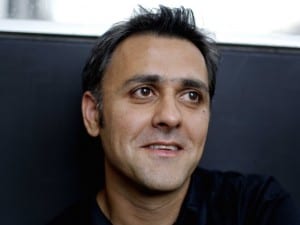On the edge of the South East coast, a small seaside town is welcoming back its most famous daughter, Tracey Emin. Banners from her last visit still adorn Margate, reading “Welcome Home Tracey!” in pink italics, but although she has clearly returned home before, this visit is perhaps her most important yet. She Lay Down Deep Beneath The Sea at Turner Contemporary is her eagerly anticipated first solo show in her hometown. As part of the London 2012 Festival, this exhibition contains recent and new work; it is a gift to Margate – “I wanted to make work that was completely new because I owe it to Margate for all Margate’s given me…”, Emin says, “…I want Margate to be celebrated again.”
Submerged in an aquamarine blue, the stairway ascent to the gallery space is illuminated by a neon piece bearing the title of the show. It is suggestive of entering the sea: the moment when one’s eyes open under water and begin to make out shapes. The woman who lies deep beneath this sea is, of course, Emin, and as one climbs the stairs, a paradoxical feeling of sinking deeper under the ocean overwhelms the viewer. Known for her neon works, we are greeted on the first floor Balcony Gallery by another: a seductive Tracey in green, horizontal, adorned with the shadows of other viewers and the glimmering reflection of one of the gallery’s most impressive sea views. On the wall is a small painting, the words “I Said No” scrawled in capitals, a sickening green, reminding us of Emin’s more painful and traumatic memories of growing up in Margate.
The work in the West Gallery, hung with a striking sensitivity to space, mostly depicts a single repeated motif of a reclining female figure in gouache. Emin’s obsessive reproduction of herself, she says, is born of a desperation to discover something new. The urgency of these swiftly drawn reductions of the female form are however contrasted by embroidered versions of the same image. From a distance, these pieces, such as Dark Recline, could easily be mistaken as gouache, the swelling inconsistencies of line mirroring brush strokes, but on closer inspection the blue breaks up into tiny threads, shades fluidly merging into one another. Emin’s commandment over simplicity is transformed into a mesmerising intricacy. The tranquillity of this room is comforting and mellow, away from Emin’s more confrontational style and better-known “bad girl” side. Her work, she explains, is now about focussing on positivity. “I want to stop worrying about all the things that are negative and try and get a better balance in my life. And I do have a really good life, I don’t have much to complain about!”
In the South Gallery, Emin appears in her work as Picasso’s famous muse, Marie-Thérèse Walter. Her cheeks are scattered with cross-stitch kisses, her eyes are slanted and her smile is distorted in a room no longer repeating body, but repeating face. Here also, there is a set of exquisite tapestries: “I want these for my home!” Emin exclaims. The muted shades of these works, however, and the extreme closeness and subtlety of colour are unfortunately lost against the brighter shade of the walls, a quite distracting pistachio green. Despite this, the other works in the South Gallery, particularly a white neon scrawl reading “I Followed You Into The Water Knowing I Would Never Return” and the Picasso-esque portraits, buzz against this choice of wall-colour and glow.
The final gallery space adopts a darker tone. Mono-prints reading “I’m Afraid” and “I Cannot Love How Love Is Told It Should Be” highlight the negative elements of relationships. There are also four embroideries here of heavy blacks and dark blues, contrasting to the brighter shades of the first room. A stained, used mattress weighed down by a cast bronze bare branch sits in the corner, signifying things lost, gone, vanished and dying; “A lot of this work is about being a woman, being nearly fifty, and lots of things ending for me and never being the same again.” Despite this bleak resolution however, Emin’s exhibition does seem to signify a new direction in her work: one of comfort, subtlety and a quiet exploration of her own self.
Emin and her art seem at home in Margate. Surrounded by a vast and gaping coastline, Turner Contemporary is a space in constant conversation with the sea. Emin manages to bring this relationship closer: her work floods the building with tumultuous greens, soft blues and the black of the inconceivable and immeasurable depth of the ocean. Upon visiting this exhibit, we do indeed find the artist lying at the bottom, hidden in her gouache nudes and exposed in her soft tapestries. Here in Margate Tracey is waiting for the sea, either love or death, to claim her.
Tracey Emin: She Lay Down Deep Beneath the Sea, 26/05/2012 until 23/09/2012, Turner Contemporary, Rendezvous, Margate, Kent, CT9 1HG. www.turnercontemporary.org
Credits:
1. Tracey Emin She Lay down Deep Beneath The Sea (2012) Neon © the artist.
2. Tracey Emin I Didn’t Say (2011) Gouache on paper © the artist.
3. Tracey Emin I Said No acrylic on board © The artist
4. Tracey Emin Sex 1 (25-11-07) Sydney © Tracey Emin / Tracey Emin studio
5. Tracey Emin Last in Love (2011) Gouache on paper © the artist.
Images 1, 2 and 5 Photo: Ben Westoby. Courtesy of White Cube.
Text: Claire Hazelton
More on Tracey Emin:
Review of Love Is What You Want at Hayward Gallery, London.




